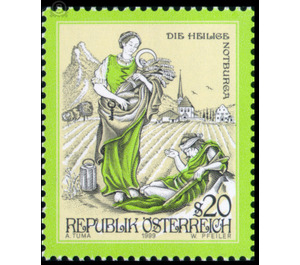Myths and legends - Austria / II. Republic of Austria 1999 - 20 Shilling
Theme: Architecture
| Country | Austria / II. Republic of Austria |
| Issue Date | 1999 |
| Face Value | 20.00 |
| Printing Type | combination printing |
| Stamp Type | Definitive |
| Item Type | Stamp |
| Chronological Issue Number | 1633 |
| Chronological Chapter | OOS-OE2 |
| SID | 351777 |
| In 62 Wishlists | |
Notburga is the saint of the small, inconspicuous life. She is great before God, because charity was just as important to her as the love of God. Her simple love service, her devotion to God and her neighbor made her so popular. Because she was not a nobleman, not an abbess, not a theologian and not an academic, she has become the patron saint of Tyrol. Notburga lived in a time in which Rudolf von Habsburg sat on the German royal throne and ruled in the County of Tyrol Meinhard II. At that time the contrast between poor and rich was very great. But with Francis of Assisi and Elizabeth of Thuringia and the Beguine community, the Church has become friends with the sick, the poor and the helpless. St. Notburga also had a big heart for the poor. Their name, composed of the Old High German "not" (distress) and "burga" (protection, refuge) means to grant protection in distress. In the foreground of the stamp is a beggar, for whom Notburga has an open heart, in the background stands the church of Eben, where the saint often prayed and also found her final resting place. But only prayer and work, the "Ora-et-labora" of St. Benedict, God and human service, carry on our lives and our society. This message is very topical and should be made aware of by the stamp once again.


